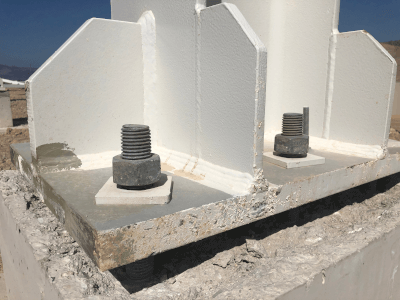What Is an Anchor Bolt?

Anchor bolts are screws that fasten wood or metal structural members or equipment to floors or walls.
Anchor bolts can be manufactured by rolling or cutting. Rolling is a manufacturing method that uses plastic deformation to create threads. In contrast, cutting is a manufacturing method in which threads are formed by hand or automatically using a machine.
Compared to cutting screws, thread rolling screws are considered to have higher strength and can be used according to conditions.
Uses of Anchor Bolts
Anchor bolts can be used to prevent equipment and other devices to which they are attached from separating, moving, or tipping over.
For example, if a unit with a drive unit is installed on a frame, vibration is generated when the unit moves on the frame. Since the unit is strongly fastened to the frame, the vibration is transmitted directly to the frame, which shakes in response to the vibration and may move or topple over if the vibration becomes significant.
This situation can be prevented by using anchor bolts to fasten the legs of the trestle to the floor and allow the vibration to escape to the floor.
Principle of Anchor Bolts
Calculate the shear and tensile forces created in an anchor bolt. The allowable shear and tensile forces of the anchor bolt and the allowable pullout force from the concrete are calculated, and the embedment length, material, and thickness can be determined so that the shear and tensile forces of the anchor bolt are not exceeded.
For tension, the smaller of the allowable pullout force from the concrete and the allowable pullout force of the anchor bolt is used. If the allowable tensile force of the anchor bolt is greater than the allowable pullout force from the concrete, the concrete will fail first. Furthermore, if the allowable tensile force of the anchor bolt is less than the allowable pullout force from the concrete, the steel will yield first.
Where earthquake resistance is required for columns, beams, bearing walls, etc., the design must be such that the allowable tensile force of the anchor bolt is less than the allowable pullout force from the concrete.
Types of Anchor Bolts
Anchor bolts have different characteristics depending on the type. The main types are as follows:
1. Internally Threaded Anchor
This is the most common type of anchor bolt. The bolt can be driven into the floor or wall surface with no protrusion on the surface.
2. Anchor Bolt With a Core Rod
Anchors that can be cast directly on top of the object to be fastened. There are several types of anchors such as All Anchor, Best Anchor, Rooty Anchor, C-type anchor, and Tight Anchor.
3. Adhesive Anchor
Also called chemical anchors because they are fastened with an adhesive, there are two types: capsule type and injection type. In the capsule method, a hole is first drilled, a capsule containing adhesive is inserted, and the anchor is driven into the hole, causing the adhesive in the capsule to leak out and fix the anchor in place. On the other hand, in the injection method, the adhesive is injected directly into the drilled hole, and the anchor bolt is then driven into the hole.
4. Welded Anchor
The object to be fastened is fixed by welding. The head part can be directly welded and fixed, and the size is small.
5. Grip Anchor
Can be used for fastening to concrete. The anchor body is driven into the concrete. The anchor body is threaded and the object is fastened when the anchor bolt is tightened.
6. Board Anchor
Board anchors are used to attach components such as hollow structural walls or plasterboard. They can withstand a certain amount of weight and are available in various types. Some types can be installed without damaging the wall and are made of fire-resistant steel. However, many types are non-removable.
7. Anchor for ALC
These anchors are used to attach lightweight foamed concrete panels to metal fittings. They can be used in a wide range of situations, depending on their strength. Anchors for ALC with excellent heat, chemical, impact, and weather resistance are also available.
8. Fastening Anchor
Fasten to concrete as if tightening a screw. Requires hole depth.
9. High-Performance Anchor
Easy installation by simply turning a bolt. Can be installed with power tools, reducing work time.
10. Anchor for Hollow Wall
Can be classified into Amera hanger and IT hanger. Amera hangers have a short roll plate and are suitable for installation in hollow walls, while IT hangers can be penetrated with holding power and do not damage the surrounding area because they work while the installation device is in place.